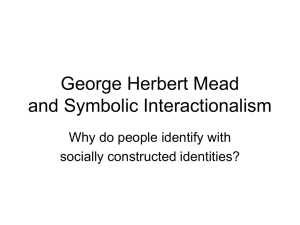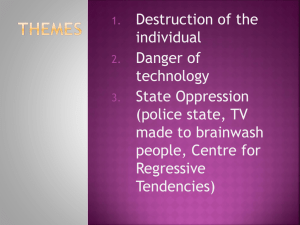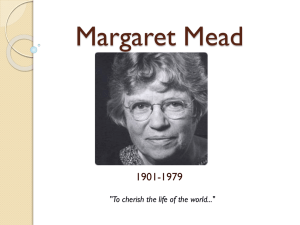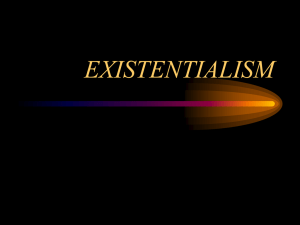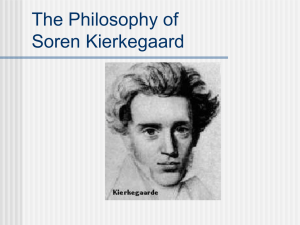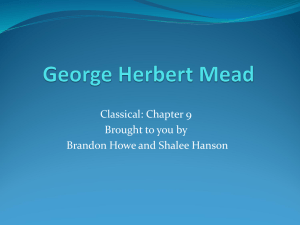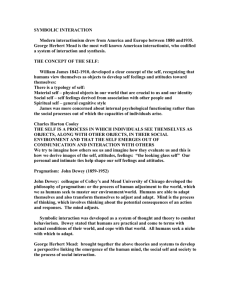George Herbert Mead and Sören Kierkegaard as theorists of the self
advertisement
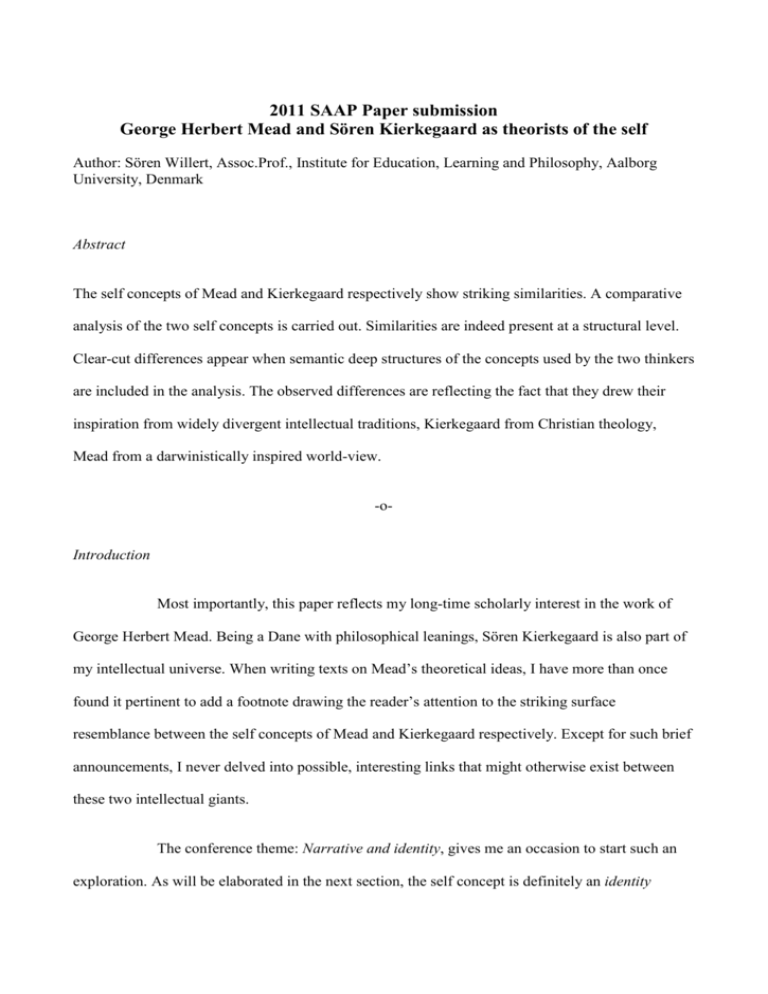
2011 SAAP Paper submission George Herbert Mead and Sören Kierkegaard as theorists of the self Author: Sören Willert, Assoc.Prof., Institute for Education, Learning and Philosophy, Aalborg University, Denmark Abstract The self concepts of Mead and Kierkegaard respectively show striking similarities. A comparative analysis of the two self concepts is carried out. Similarities are indeed present at a structural level. Clear-cut differences appear when semantic deep structures of the concepts used by the two thinkers are included in the analysis. The observed differences are reflecting the fact that they drew their inspiration from widely divergent intellectual traditions, Kierkegaard from Christian theology, Mead from a darwinistically inspired world-view. -o- Introduction Most importantly, this paper reflects my long-time scholarly interest in the work of George Herbert Mead. Being a Dane with philosophical leanings, Sören Kierkegaard is also part of my intellectual universe. When writing texts on Mead’s theoretical ideas, I have more than once found it pertinent to add a footnote drawing the reader’s attention to the striking surface resemblance between the self concepts of Mead and Kierkegaard respectively. Except for such brief announcements, I never delved into possible, interesting links that might otherwise exist between these two intellectual giants. The conference theme: Narrative and identity, gives me an occasion to start such an exploration. As will be elaborated in the next section, the self concept is definitely an identity marker for human beings, both as individuals and as a biological category (species). As will be pointed out in later sections, the crucial difference between the self concepts of Mead and Kierkegaard relates to the two philosophers’ very different choice of narrative framework for understanding human existence. The self as theoretical concept In Western philosophy and history of ideas, the self as theoretical concept has been there all along. Socrates did not himself coin the phrase Know thyself, but borrowed it from the entrance door to the Delphian Oracle. Since his days the phrase has, in our part of the world, remained a much favoured quotation in texts dealing with man’s search for his root identity. Simple logic tells us, doesn’t it, that if attainment of self-knowledge is part of man’s sincerest obligations towards … well, himself, then, of necessity, there must also be a self that can be known. Or must there indeed? That question is still being debated.1 If Socrates counts as one founding father of Western history of ideas, then the preSocratic philosophers were part of his foundation. Among pre-Socratic philosophers you find the fixed controversy between Heraclitus (stability is an illusion, everything is motion) and Parmenides (motion is an illusion, stability is everything). For as long as the self has been around as theoretical concept, it has also has been a battleground within the Heraclitus-Parmenides controversy. During the twentieth century the words ‘essence’ and ‘essentialism’ were important terminological markers in the Heraclitus-Parmenides controversy over self. Proponents of Heraclitic 1 In Gallagher, S. & Shear, J. (eds.) (1999) Models of the Self. Thorverton (UK): Imprint Academic, the reader is taken through, altogether, 29 articles without ever being told, in unambiguous terms, whether such a ‘thing’ as the self can actually be said to exist. positions called their Parmenidean counterparts defenders of an essentialist position. Around midCentury, such name-calling might originate from intellectuals with existentialist sympathies (re the catch-phrase ‘existence before essence’). Towards the end of the Century similar name-calling might reflect social constructionst thinking (as part of the general post-modernist trend). One characteristic shared by Mead and Kierkegaard as historical figures is that both have been acclaimed as early proponents of viewpoints which, at a later date, were developed into fullblown intellectual traditions. Thus Kierkegaard is seen as spiritual ancestor to existentialism, Mead likewise as an early forerunner of social constructionism. This shared heraclitic leaning may go some way towards explaining the seeming similarity between their respective self concepts. Two self concepts: a first approximation As implied above, the self concepts endorsed both by Kierkegaard and by Mead seem to be of the Heraclitic rather than the Parmenidean variety. Of the two, Kierkegaard’s self concept is by far the easiest to locate and to convey. When starting one of his most important treatises, Sickness unto Death2, it takes Kierkegaard no more than three sentences to arrive at the following rhetorical question: “What, then, is the self?” – this question being immediately followed by a 33 words long, succinct even if slightly enigmatic, root definition of the concept. “The self is a relationship relating to itself – or is the feature that this relationship relates to itself. The self is not the relationship, but the fact that the relationship relates to itself.”3 2 3 Kierkegaard, S. (1962) Samlede værker (Collected Works). Vol. 15, pp. 73-180. Copenhagen: Gyldendal Danish language quotations are translated by the author. When it comes to Mead’s self concept, the posthumously published text Mind, Self and Society will serve as my main literary source. As is the case with many of Mead’s core concepts, they are not handed over to the reader in the form of neatly defined packages, but rather have to be pieced together from many separate discussions, deliberations and examples. This textual peculiarity reflects the fact that the book was, indeed, never written by its ‘author’, but is based on edited stenographic lecture material. From among many possible starting points for unwinding the Meadian self, I choose the one which makes the affinity with Kierkegaard’s definition most apparent.4 “It is the characteristic of the self as an object to itself that I want to bring out. This characteristic is represented in the word ‘self,’ which is a reflexive, and indicates that which can be both subject and object.” In philosophical parlance, the subject-object word pair denotes an epistemic relationship between a knowing agent (subject) and a known something (object). Important philosophical debates have been dealing with the question whether a clear subject-object distinction can be drawn, and – if at all possible – what the criteria for such a distinction might be. Mead’s description of the self as ’that which can be both subject and object’ carries the implication that, when it comes to the self, the distinction may indeed not be applicable. The self has object characteristics as well as subject characteristics. By using the term ‘reflexive’ he further ascribes to the self the quality of gaining whatever identity it may have through some kind of mirroring activity. In so far as the self is subject, it attains this quality through mirroring itself in the object. In so far as the self is object, it becomes so through mirroring itself in the subject. Incidentally, the latter part of my explication of Mead’s position points to another seeming resemblance between the two self concepts here compared, namely their close affinity to 4 Mead, G.H. (1934) Mind, Self, and Society. Chicago: University of Chicago Press, pp. 136f. the concept of consciousness. In his texts Kierkegaard may use the two terms: self and consciousness, interchangeably. Likewise (as will become clear later) Mead’s self is one that continually gets established through (using a phrase he himself does not use) epistemic acts. The material I have thus far presented clearly shows the basic Heraclitic leanings of the two self theorists examined. Both point to the act of consciously relating as an essential feature of the self – the essence of which seems, otherwise, hard to convey in unambiguous object language. I shall now start a search for the implied relata of the relational self as conceived by Kierkegaard and Mead respectively. The self as essentially human The seeming similarity of Mead’s and Kierkegaard’s root definitions of the self was what originally pushed me into writing this paper. The overarching question that shall guide me in doing a comparative study between them will be: “How far does the similarity go?” If looked at broadly as intellectual figures, many obvious differences separate the two thinkers. I will follow a strategy of focussing on similarities as far as possible without seriously misrepresenting either of the two. One similarity aligning them as self theorists is their understanding of the self as not only a constitutive element in the psychic makeup of human beings, but also an exclusive element, i.e. one with which humans, but no other natural beings are endowed. Differences arise when it comes to elucidating the background to and implications of this exclusivity. I start by explicating Kierkegaard’s view of man’s special position in nature. Kierkegaard: The self as a – fallible – epistemic bridge between natural man and God Kierkegaard died in 1855 i.e. four years before the publication of Darwins’s The Origin of Species, a book which was destined to set completely new standards for the understanding of man in a natural context. The idea of a developmental linkage between man and beast, however, was not an invention of Western biology. According to Genesis, the day before God created man, He was busy creating the animal kingdom. Each consecutive creational act was an expression of a new layer of His grand design for the world – a design which human Christians, Kierkegaard included, may busy themselves trying to fathom. According to the Christian creation myth – which served as an important narrative framework for Kierkegaard – awareness of the difference between good and evil is the all important separation point between humans and non-human animals. As originally created and incarnated by God, Adam and Eve had access to eternal living, outside the birth-death cycle of historicity. They lived among the animals, but at the same time their capacity as language users set them apart from the animals: By naming them they could make them objects of knowledge. Knowledge of themselves, however, they only got the moment when first Eve, then Adam too, wilfully chose to defy God’s ban on eating from the tree of knowledge. Through this act they became endowed with self-consciousness, i.e. subject-based reflective awareness of themselves as beings-in-the-world, i.e. as objects among other objects. As self-conscious beings – further punished for their crime by being expelled from the Garden of Eden – their (partial) understanding of God’s design, reaching from eternity to eternity, was augmented by their understanding of themselves as historical beings, unconditionally tied to the birth-death cycle and continually falling short of the demands put to them as participants in God’s design. Kierkegaard’s elaborate understanding of the self as a relationship relating to itself is based on the Christian myth of creation. On the one hand we are incarnated mortal beings and as such driven by whatever impulses Nature has instilled in us. On the other hand we are spiritual beings and, in that capacity, active stakeholders in God’s design. Our life is lived in the tension necessarily existing between these to layers of existence: the secular and the sacred; the time-bound and the eternal. When seen in the context of its immediate textual surroundings, Kierkegaard’s root definition of the self, quoted above, tells the same story; as will be shown below. Of the three sentences preceding this root definition, the first one puts equation mark between man and spirit: “Man is spirit.” The next sentence invites the reader into a query concerning the term spirit: “But what is spirit?” This question Kierkegaard answers by putting equation mark between spirit and self: “Spirit is the self.” In the text immediately following the root definition, Kierkegaard moves on to further elucidating the implications following from thus equating spirit and self. First he defines the condition of man before his attainment of the self: “Man is a synthesis of the infinite and the finite, of the temporal and the eternal, of freedom and necessity, in brief: a synthesis. A synthesis is a relationship between two parts. Thus conceived, man is not yet a self. (…) But if this relationship is also relating to itself, the relationship thus created become a positive third, and this is the self.” Kierkegaard’s position can be summarized as follows: Man is part of worldly nature. As such he is passion-driven and mortal. Man is also part of God’s grand design. As such she somehow may reach out for eternity and can in principle rise above her passions. The said duality is inbuilt in man’s existence whether or not he happens to be aware of it. Selfhood is attained by man to the extent that she chooses to relate in a conscious manner to the duality. According to Kierkegaard, the drama attached to the attainment of selfhood lies in the fact that the duality of which the self is aware consists of contraries that are patently irreconcilable – at least in the world where we, as mortal human beings, live our lives. In practice we cannot but keep repeating the original sin committed by the first humans, Eve and Adam. Mead: The self as a – fallible – epistemic bridge between natural man and society Mead was not a Christian thinker. Still, Christianity played an important role in shaping him as a professional person. During his late teens, Mead went through a period of intense inner turmoil dictated, on the one hand, by his ardent wish to distance himself from the strong Christian worldview he had inherited from his family-of-upbringing, on the other hand by his inability to locate those guiding principles that might fill the void thereby created.5 To make a long story short, Darwinism was what finally filled that void. My deepening understanding of Mead over the years has made me see him as a thinker whose intellectual profile was, to an extraordinary degree, shaped by his efforts to generalize a Darwin-inspired world-view (or narrative) far beyond the habitual confines of biology and, indeed, to experiment with ‘biologizing’ ontology.6 This overarching intellectual programme also left an imprint on the way he conceived of the human self. As described above, self according to Kierkegaard emerges when a person chooses, wilfully and consciously, to relate to a relational structure that is an inherent part of her being-inthe-world, whether or not she acknowledges this fact. By thus relating, she at the same time becomes aware of her relatedness to an external part ‘out there’ that serves as an inexorable source of her existence, namely God. As I intend to show, Mead’s notion of self in founded on a similar Mead’s youthful religious scruples are described in Cook, G.A. (1993) George Herbert Mead – The Making of a Social Pragmatist. Urbana: University of Illinois Press, p. 6ff. 6 Space does not allow me to develop or exemplify this argument any further. Suffice it to say that, among Mead’s major works, I see The Philosophy of the Present (1932, Chicago: Open Court Publishing Co.) as the clearest example of his supposed efforts at ‘biologizing’ ontology. 5 conceptual structure – but the semantic contents of the structure’s discrete building blocks have been radically altered as a consequence of Mead’s replacement of Christianity by a Darwinistic world-view. In the Kierkegaard case, the relational structure forming the ‘first layer’ of the self consisted of highly abstract components: the finite as opposed to infinity, etc. For Mead, the same ‘first layer’ is composed of the natural relation between a concrete organism and its environment, and with action-based meaning as the relational feature linking the two, one to the other, in reciprocal fashion; cf. the quote below: ”The distribution of meaning to the organism and the environment has its expression in the organism as well as in the thing (…) There is an expression of the organized response of the organism to the environment, and that reaction is not simply a determination of the organism by the environment, since the organism determines the environment as fully as the environment determines the environment. // And since organism and environment determine each other and are mutually dependent for their existence, it follows that the life process, to be adequately understood, must be considered in terms of their interrelations.”7 The quoted passage explicates ‘meaning’, not as an exclusive feature of human life, but as a core concept for understanding life forms at any phylogenetic level. Human beings are special in that they may relate consciously to the meaning aspects of whatever they are doing, but “(a)wareness or consciousness is not necessary to the presence of meaning in the process of social 7 Mead, 1934, p.129//130. Incidentally the quoted passage gives a hint as to why Mead (as I said earlier) may be considered as ‘in certain respects, an early forerunner of social constructionism’. experience. (…) The mechanism of meaning is (…) present in the social act before the emergence of consciousness or awareness of meaning occurs.”8 Not only (says Mead) does meaning depend on action rather than awareness for its occurrence. In the last quote, he further describes ‘action’ as ‘social act’. This phraseology is far from accidental, and points at yet another radical difference between his thinking and that of Kierkegaard. More than anything, Kierkegaard’s philosophy is directed towards the singular individual.9 For Kierkegaard, joining the crowd unthinkingly comes close to self-betrayal. Realization of the self means staying true to whatever sets the person apart from the crowd – even if a price has to be paid. Contrariwise, for Mead the very process of attaining individuality and selfhood presupposes the presence of a ‘structured crowd’, i.e. a community or society. “For social psychology, the whole (society) is prior to the part (the individual), not the part to the whole; and the part is explained in terms of the whole, not the whole in terms of the part or parts.”10 The abstract principle here stated gains concrete significance when Mead goes on to explain how meaning originates in and is expressed through turn-taking between different organisms in goal-directed action. ”(T)he nature of meaning (…) is found to be implicit in the structure of the social act (…): namely in the triadic relation of a gesture of one individual, a response to that gesture by a second individual, and completion of the given social act by the gesture of the first individual.”11 8 Op.cit., p.77. In a posthumously published treatise, Aims of my work as an author, Kierkegaard himself (1962, vol. 18, p.91) points at the singular individual as opposed to the crowd as the intended target for his writings. 10 Mead, 1934, p.7. 11 Mead, 1934, p. 81f. 9 Following the above preliminary remarks concerning the deep structure of Mead’s theoretical edifice, I shall now formulate my own ultra-brief version of Mead’s hypothetical answer to Kierkegaard’s earlier cited, rhetorical question: “What, then, is the self?” Like all organisms the human life form is dynamically related to its social and physical environment, namely through meaning structures specifying not only possible action fields but also possible action partners. Examples: Predators are pre-programmed to recognize (in a functional way) their prey – and vice versa. The newborn human mammal is pre-programmed to recognize human faces – and greet them with that adorable smile which makes the face-owners want to relate to the baby and make him part of the family. The implementing agent responsible for bringing meaning structures into social play is by Mead called the I. The I is understood as an “immediate human response to a perceptual world” representing an “unfractured relation between the impulses and the objects which give them expression”.12 Like no other organism the human life form has the capacity to relate itself dynamically to the meaning structures mediating its own life-sustaining activities, namely by turning them into action fields, on an individual and / or collective basis. Mead names this capacity the human mind function. It rests on biological design components allowing humans to represent meaning structures to themselves in the form of linguistically (and culturally) mediated structures of signification. Those signification structures which, at any given moment, serve as a person’s representation to herself of herself-as-meaning-structure Mead labels the me. The semantic contents of the me reflect on the one hand the person’s continued observation of herself-as-acting-I, on the other hand culturally sanctioned interpretations of what human life, in its various, socially 12 Mead, 1934, p. 350. structured manifestations, is all about. The linguistically mediated symbolic structures used by humans for self-interpretative purposes Mead calls the generalized other. The self, according to Mead, is “essentially a social process going on with these two distinguishable phases”, i.e. the I and the me. As a result of their continued dialogue the life process may proceed with its mixture of wilful social responsibility (contribution of the me) and emergent, unpredictable novelty (contribution of the I). This particular mixture, which is made possible by the self as double-loop relational structure, makes the life process of the human species stretched out between naturally and culturally generated existential demands. Summary and conclusion Mead’s and Kierkegaard’s conceptions of the self share structural similarities. Both conceive of the self as heraclitic motion: a relationship relating to itself in an unending fashion. The dialectical tension within the relationship cannot be finally put to rest through human action. Existentially speaking, self-as-motion is a sine qua non. Further, they both describe one of the two agents making up the relationship in roughly comparable ways. Apart from the notion of ‘sin’, Kierkegaards ‘secular man’ and Mead’s I belong to the same basic anthropological category. When it comes to describing agent number two of the relationship, my two main protagonists radically disagree. For Kierkegaard this agent is ‘spiritual man’ carrying a potential awareness of God’s design. Mead names the agent ‘the me’ and understands ‘her’ as carrying an awareness of guidelines, shared by particular social communities, concerning proper human conduct. According to Kierkegaard, man finds him in a dialectical tension field between two fixed sets of existential conditions: animal nature and timeless spiritual truths. According to Mead, the tension is between two historically changeable entities. The acting I and the reflective, tentatively monitoring me are continually modifying each other in response to historical development – and as a contribution to that same development. In this paper I have unravelled these similarities and differences, including their background. I have also made use of the all the space (number of signs) allotted to me! The logical next step will be to try and unravel the self- and life-related corollaries following from the two existential positions I have investigated.
